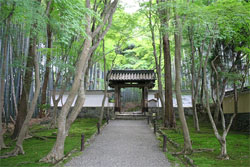Saiho-ji or Koke-dera (Moss Temple) is an ancient temple said to have been established by the monk Gyoki during the Nara Period. The temple was restored and converted into a Zen temple by the monk Muso Soseki in 1339.

The precincts are covered by more than 120 types of moss, resembling a beautiful green carpet - thus its other name, Kokedera Temple, which literally means "Moss Temple."
The garden, designated as a special place of scenic beauty, consists of a lower landscape garden surrounding a pond shaped like the Chinese character kokoro (heart), and an upper dry landscape-style rock garden built by Muso Soseki. This garden has exerted a great deal of influence on later Japanese gardens.
History
Founded by a priest named Gyoki in the Nara Period (710-794), it was refurbished in 1339 by Muso Kokushi/Soseki, a famous landscaper. The garden of the Buddhist Rinzai-shu sect temple is a wonderful mixture of natural beauty and landscaping and is famous for its velvety-green 120 different kinds of moss spread underneath the trees.
What to see
What is amazing about Saihoji's garden is that it was never planned to be covered in moss. Muso had planned for a garden divided into two parts, one the Chisen Kaiyu (circling pond) while the other was to be a karesansui (dry garden) type. After the garden was finished the moss naturally grew, with no help from external forces. The fact that this garden's beauty was only half planned by a man makes it genuinely sublime.
To enjoy the garden's peaceful atmosphere, visitors need to make a reservation as Saihoji is completely indifferent to the mass tourism destinations elsewhere in Kyoto, as the priests running the temple wish to keep the solemn, peaceful atmosphere intact.
While the temple is sparse in buildings those of interest would be the two tea houses, one being Shonantei, and the Founder's Hall. Aside from those the real purpose of coming to Saihoji is to experience the magnificent garden.
The central garden is focused around a pond in the shape of the Chinese character for heart or "Kokoro". Located throughout the temple grounds, from the moment you walk in, are over 120 species of moss flowing over the ground in a soft, cool blanket of green. Even the bridges over the water have not escaped the soothing green wave. Saiho-ji is said to be at its best just after rain.
The islands within the pond are called Horai, Tsuru, and Kame and are supposed to represent the Buddhist idea of paradise. The rock formation near the Horai Isle, called Yodomari-shi, is considered to be anchored boats on the way to or from Paradise.
The dry garden of Saihoji is thought to be the first karesansui and is thought to be the example for all dry gardens in Japan, including the famous rock garden at Ryoan-ji. It is also said that the Ashikaga Shoguns - Yoshimitsu and Yoshimasa, the creators of Kinkaku-ji and Ginkaku-ji respectively, were inspired by the garden here and planned the gardens of their temples according to the style set here by Muso. Be that as it may, the rock formations are not only less harsh than those at Ryoan-ji, due to their cool coat of moss but are more ornamental, in that they are only meant to be part of the lovely scenery of the temple's garden.
Visitors will take part in a Buddhist ceremony and lecture (in Japanese and include activities such as Sutra-writing demonstrations).
Saiho-ji was listed on the UNESCO World Heritage List in 1994.
Source
- The Yamasa Institute
Address
56 Jingatani-cho, Matsuo, Nishikyo-ku, Kyoto City.
Tel: 075-391-3631



